
Sacred Heart Catholic Church is a Roman Catholic church in Dubuque, Iowa. It is part of the Archdiocese of Dubuque and located at 2215 Windsor Ave. The parish was one of the locations where the movie F.I.S.T. starring Sylvester Stallone was filmed.

St. Raphael's Cathedral is a Catholic cathedral and a parish church in the Archdiocese of Dubuque located in Dubuque, Iowa. The parish is the oldest congregation of any Christian denomination in the state of Iowa. The cathedral church, rectory, former convent, and former parochial school building are a contributing properties in the Cathedral Historic District on the National Register of Historic Places.

Saint Boniface Church is the Catholic parish church for the city of New Vienna, Iowa and the surrounding area. It is a Gothic-style church, with stained glass windows, a handcarved main altar, and a striking 200-foot (61 m) spire The parish, part of the Archdiocese of Dubuque, is partnered with Ss. Peter and Paul Parish, Petersburg, Iowa - the two parishes share a pastor.

Sacred Heart Cathedral, located in Davenport, Iowa, United States, is a Catholic cathedral and a parish church in the Diocese of Davenport. The cathedral is located on a bluff overlooking the Mississippi River to the east of Downtown Davenport. It is listed on the National Register of Historic Places as part of the Sacred Heart Roman Catholic Cathedral Complex. This designation includes the church building, rectory, and the former convent, which was torn down in 2012. The cathedral is adjacent to the Cork Hill Historic District, also on the National Register. Its location on Cork Hill, a section of the city settled by Irish immigrants, gives the cathedral its nickname Cork Hill Cathedral.

The Basilica of St. Josaphat, located in the Lincoln Village neighborhood of Milwaukee, Wisconsin, United States, in the Archdiocese of Milwaukee, is one of 82 minor basilicas found in the United States. In its grandeur and opulence it is an excellent example of the so-called Polish Cathedral style of church architecture found in the Great Lakes region of North America. Modeled after St. Peter's Basilica in Rome, it features one of the largest copper domes in the world. It is listed on the National Register of Historic Places and is a designated Milwaukee Landmark.
Saint Paul's Catholic Church is a parish of the Roman Catholic Church This parish is located in Worthington, Iowa, and is part of the Archdiocese of Dubuque. St. Paul's is linked with the Basilica of St. Francis Xavier in Dyersville, Iowa - with whom it shares a pastor.
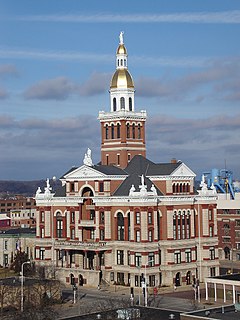
Fridolin Heer was a Swiss-born and trained architect who immigrated to the United States in 1864 and set up a practice in Dubuque, Iowa shortly thereafter. He was joined in his practice by his son, Fridolin Heer Jr.
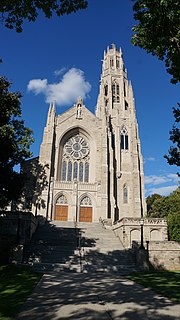
The Cathedral Basilica of Christ the King is a Roman Catholic church in Hamilton, Ontario, Canada. The cathedral was consecrated on December 19, 1933. It is the seat of the Bishop of the Diocese of Hamilton, and the cathedral of the Diocese of Hamilton. The cathedral contains the cathedra of the bishop, the Most Rev. Douglas Crosby. The cathedral was raised to the status of a minor basilica in February 2013 by Pope Benedict XVI.

The Basilica of St. John is a Minor Basilica of the Catholic Church in the Drake neighborhood of Des Moines, Iowa, United States. It is also a parish church in the Diocese of Des Moines. The church building is listed on the National Register of Historic Places.

Petersburg is an unincorporated community in Delaware County, Iowa, United States. It lies at an elevation of 1112 feet.

St. Mary's Catholic Church, also known as St. Mary of the Visitation Church, is a parish church of the Diocese of Davenport which is located in Iowa City, Iowa, United States. The church building and rectory were listed together on the National Register of Historic Places in 1980. They were both included as contributing properties in the Jefferson Street Historic District in 2004. The parish's first rectory, which is now a private home, is also listed on the National Register as St. Mary's Rectory. It is located a few blocks to the east of the present church location at 610 E. Jefferson St.
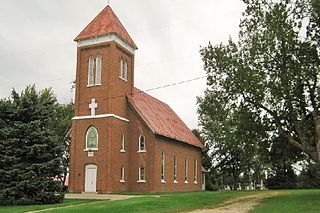
St. Joseph's Catholic Church is a former parish of the Diocese of Davenport. The church is located in Dallas township in rural Marion County, Iowa, United States. It was part of the now defunct village of Bauer. The closest communities are Melcher-Dallas and Lacona. The church building still stands and together with the adjacent cemetery comprises an historic district listed on the National Register of Historic Places.

St. John's Episcopal Church is a parish church in the Episcopal Diocese of Iowa. It is located in Keokuk, Iowa, United States. It was listed, together with the parish hall, on the National Register of Historic Places in 1989.

St. Mary's Catholic Church is a parish of the Archdiocese of Dubuque. The church is located in Guttenberg, Iowa, United States. It is listed on the National Register of Historic Places as St. Mary's Catholic Church Historic District. In addition to the church, the historic district includes the parish rectory, convent, and school building.

Saints Peter and Paul Catholic Church is a parish church in the Archdiocese of Dubuque. The church is located in the unincorporated community of Petersburg, Iowa, United States. It was listed on the National Register of Historic Places in 1995.
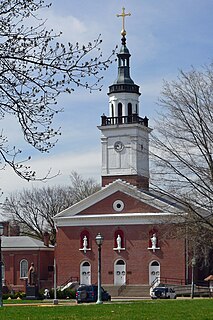
The St. Francis Xavier Cathedral is a parish of the Roman Catholic Church in Vincennes, Indiana, under the Diocese of Evansville. Named for Francis Xavier, a 16th-century Jesuit apostle, it is located opposite George Rogers Clark National Historical Park at 205 Church Street, within the Vincennes Historic District.

St. Benedict Cathedral is a Roman Catholic cathedral in Evansville, Indiana, United States. It is the seat of the Diocese of Evansville. The cathedral, rectory and original school building are contributing properties in the Lincolnshire Historic District on the National Register of Historic Places.

St. Francis Xavier Church is a Catholic church within the City of Winooski, Vermont in the United States. Built in 1870 within what was then known as a village within the township of Colchester, the parish church became one of the most visible landmarks in Chittenden County due to its unique double-spired design and proportional size comparative to its surrounding structures. The Church was listed on the Vermont State Historic Register on November 22, 1993.
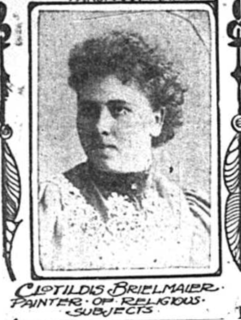
Clotilde Elizabeth Brielmaier, sometimes called "Lottie" Brielmaier, was a German-American religious painter, specializing in portraits and church murals. She was the daughter of the famous Milwaukee architect Erhard Brielmaier and often collaborated with her family members on projects. She spent several years, as many as twenty, studying at the art centers of Europe including Munich and Rome. She is said to be the first female artist to establish her own studio in the United States, which was located in the now demolished University Building in Milwaukee, Wisconsin.
St. Peter Catholic Church is the first Roman Catholic Church in Montgomery, Alabama, and the third oldest Catholic church in Alabama. It was opened in 1834, but had no resident pastor until 1850. Many of the church's original parishioners were converts from wealthy, educated, Protestant families.



























